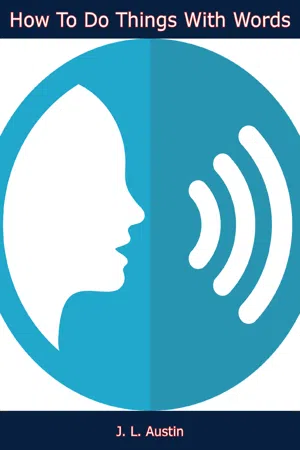![]()
APPENDIX
THE main use of the sets of hearers’ lecture notes, the B.B.C. talk on Performatives printed in the Collected Papers, the paper delivered at Royaumont under the title ‘Performatif—Constatif’, and the tape of the lecture given at Gothenburg in October 1959, has been to check the reconstruction of the text initially made independently from Austin’s own files of notes. Austin’s own notes were found at almost all points to need little supplementation from the secondary sources, being much fuller than any of them. Some characteristic examples have been added from these sources, and also some characteristic phrases at points where Austin’s own notes were not in literary form. The main value of the secondary sources has been as a check on order and interpretation at points where the notes are fragmentary.
A list of the more important places at which additions to, and reconstructions of, Austin’s text have been made is appended.
Page 28. The example about George is incomplete in the notes. The text is based mainly on the B.B.C. version.
Page 32. 2 lines from the foot to the end of the paragraph on page 33, is an editorial expansion of very succinct notes.
Page 35. All from the top of the page until, but exclusive of, the final paragraph of the lecture is a composite version from various incomplete versions in notes of differing dates made by Austin.
Page 52. The final paragraph is an expansion of Austin’s notes based mainly on those of Mr. George Pitcher.
Page 64. From this point to the end of the lecture the text is conflated from two sets of notes by Austin made prior to 1955. The 1955 notes are fragmentary at this point.
Page 70. ‘Now we can say’ to the end of the paragraph is a conjectural expansion of Austin’s notes, which read; ‘Now we use “how it is to be understood” and “making clear” (and even, conceivably, “state that”): but not true or false, not description or report.’
Page 93. In Austin’s notes Lecture VII ends here. It appears from Harvard notes that there the earlier part of Lecture VIII was included in Lecture VII.
Page 105. At line 2 ‘like implying’ is based on Pitcher’s notes. Austin has ‘Or “imply”, is it the same?’
Page 105. Paragraph (5) is expanded on the basis of hearers’ notes. The first 2½ lines only are in Austin’s notes.
Page 107. Line 2 to the end of the paragraph is added on the basis of secondary sources. It is not in Austin’s notes.
Pages 115 and 116. The illustrations to (1) and (2) are added from Pitcher’s notes.
Page 117. The paragraph beginning ‘So here are...’ is added from Pitcher’s notes.
Page 121. Line 3 ‘A judge...’ to the end of the paragraph is added from Pitcher’s notes.
Page 123. The ‘iced ink’ example, though famous among Austin’s pupils, is not in the notes. It is added from many secondary sources.
Page 124. Lines 1-4 are not in Austin’s notes; the sentence is based mainly on Pitcher.
Page 129. (a) and (b) are an expansion of very succinct notes based on secondary sources.
Pages 142 and 143. The paragraph beginning ‘Third...’ has been expanded on the basis of Messrs. Pitcher’s and Demos’s notes.
Page 162. ‘I have as usual failed...’ to the end is an expansion of Austin’s notes based partly on a separate short manuscript note by Austin and confirmed by hearers’ notes.
J. O. U.
![]()
REQUEST FROM THE PUBLISHER
Thank you so much for reading our book, we hope you really enjoyed it.
As you probably know, many people look at the reviews before they decide to purchase a book.
If you liked the book, could you please take a minute to leave a review with your feedback?
60 seconds is all I’m asking for, and it would mean the world to us.
Thank you so much,
BARAKALDO BOOKS
![]()
{1} It is, of course, not really correct that a sentence ever is a statement: rather, it is used in making a statement, and the statement itself is a ‘logical construction’ out of the makings of statements.
{2} Everything said in these sections is provisional, and subject to revision in the light of later sections.
{3} Of all people, jurists should be best aware of the true state of affairs. Perhaps some now are. Yet they will succumb to their own timorous fiction, that a statement of ‘the law’ is a statement of fact.
{4} Not without design: they are all ‘explicit’ performatives, and of that prepotent class later called ‘exercitives’.
{5} [Austin realized that the expression (I do’ is not used in the marriage ceremony too late to correct his mistake. We have let it remain in the text as it is philosophically unimportant that it is a mistake. J. O. U.]
{6} Still less anything that I have already done or have yet to do.
{7} ‘Sentences’ form a class of ‘utterances’, which class is to be defined, so far as I am concerned, grammatically, though I doubt if the definition has yet been...

